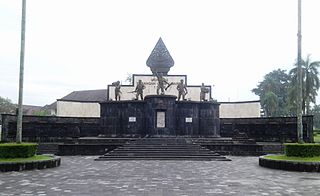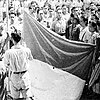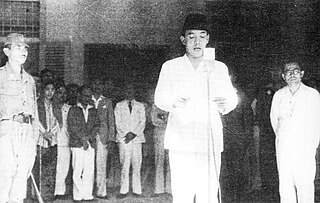
The Indonesian National Revolution also known as the Indonesian War of Independence, was an armed conflict and diplomatic struggle between the Republic of Indonesia and the Dutch Empire and an internal social revolution during postwar and postcolonial Indonesia. It took place between Indonesia's declaration of independence in 1945 and the Netherlands' transfer of sovereignty over the Dutch East Indies to the Republic of the United States of Indonesia at the end of 1949.

Surakarta, known colloquially as Solo, is a major city in Central Java, Indonesia. The 46.72 km2 city adjoins Karanganyar Regency and Boyolali Regency to the north, Karanganyar Regency and Sukoharjo Regency to the east and west, and Sukoharjo Regency to the south. On the eastern side of Solo lies Solo River. Its metropolitan area, consisting of Surakarta City and the surrounding six regencies, was home to 6,837,753 inhabitants according to the official estimates for mid 2023, 526,870 of whom reside in the city proper.

Sri Sultan Hamengkubuwono IX (Hanacaraka: ꦯꦿꦶꦯꦸꦭ꧀ꦡꦟ꧀ꦲꦩꦼꦁꦑꦸꦨꦸꦮꦟ꧇꧙꧇, often abbreviated as HB IX was an Indonesian politician and Javanese royal who was the second vice president of Indonesia, the ninth sultan of Yogyakarta, and the first governor of the Special Region of Yogyakarta. Hamengkubuwono IX was also the chairman of the first National Scout Movement Quarter and was known as the Father of the Indonesian Scouts.

Politionele acties, also politiële acties, in its narrowest definition refers to two major military offensives undertaken by the Netherlands on Java and Sumatra against the Republic of Indonesia during its struggle for independence in the Indonesian National Revolution. In Indonesia they are known collectively as the Agresi Militer Belanda, although the less common translation Aksi Polisionil is also used.

Yogyakarta is the capital city of the Special Region of Yogyakarta in Indonesia, in the south-central part of the island of Java. As the only Indonesian royal city still ruled by a monarchy, Yogyakarta is regarded as an important centre for classical Javanese fine arts and culture such as ballet, batik textiles, drama, literature, music, poetry, silversmithing, visual arts, and wayang puppetry. Renowned as a centre of Indonesian education, Yogyakarta is home to a large student population and dozens of schools and universities, including Gadjah Mada University, the country's largest institute of higher education and one of its most prestigious.

Operation Kraai was a Dutch military offensive against the de facto Republic of Indonesia in December 1948, following the failure of negotiations. With the advantage of surprise, the Dutch managed to capture the Indonesian Republic's temporary capital, Yogyakarta, and seized Indonesian leaders such as de facto Republican President Sukarno. This apparent military success was, however, followed by guerrilla warfare, while the violation of the Renville Agreement ceasefire diplomatically isolated the Dutch. This led to the Dutch–Indonesian Round Table Conference and recognition of the United States of Indonesia.

This is the timeline of Indonesian National Revolution.

Amir Murtono, also spelled Amir Moertono, was an Indonesian former general who served during Suharto's New Order regime, and gained prominence as Chairman of Golkar from 1973 to 1983.

Sjafruddin Prawiranegara was an Indonesian statesman and economist. He served in various roles during his career, including as head of government in the Emergency Government of the Republic of Indonesia, as Minister of Finance in several cabinets, and as the first Governor of Bank Indonesia. Sjafruddin later became the prime minister of the Revolutionary Government of the Republic of Indonesia, a shadow government set up in opposition to the country's central government.
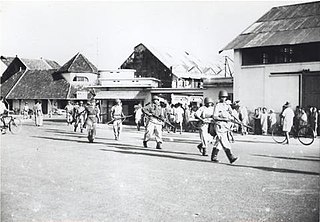
The Makassar Uprising, also known as Andi Aziz rebellion, was a skirmish in Makassar, Sulawesi, between former Royal Dutch East Indies Army soldiers under Captain Andi Aziz and the Republic of the United States of Indonesia government. The purpose of the uprising was to revolt against the incorporation of the Indonesian federated "states" into the Indonesian Republic. However, the uprising was quashed in a little over two weeks when troops under Lieutenant Colonel Suharto and Colonel Alexander Evert Kawilarang arrived at Makassar to find only light resistance.

Sudirman was a high-ranking Indonesian military officer during the Indonesian National Revolution. The first commander of the Indonesian National Armed Forces, he continues to be widely respected in the country.
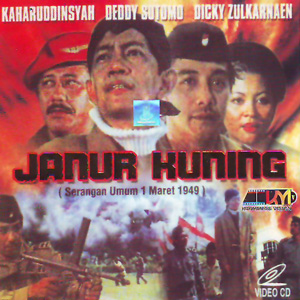
Janur Kuning is a 1980 Indonesian war film directed by Alam Surawidjaja and produced by Abbas Wiranatakusuma. Starring Kaharuddin Syah, Deddy Sutomo, and Dicky Zulkarnaen, it follows the Indonesian revolutionaries six-hour assault on Yogyakarta, under Suharto, in a show of force against the Dutch army. At the time the most expensive domestic production ever, the film's title is meant to symbolise the Indonesian people's struggle. A critical success, Janur Kuning received a nomination and two special awards at the 1980 Indonesian Film Festival. It was screened annually on 1 March between 1980 and 1998, but has since been criticised as an attempt to manipulate history and create a cult with President Suharto in the centre.

Enam Djam di Jogja is a 1951 Indonesian film directed by Usmar Ismail. It was the second film to be produced under the PERFINI banner. Detailing the show of force in which the Indonesian republican army retook the capital at Yogyakarta for six hours, the film utilised much of the cast and crew from Ismail's previous work Darah dan Doa (1950). The film was a success in Indonesia and continued to be screened on the state television channel into the 1980s, even after two further films about the event were released.

Suharto was the second President of Indonesia, having held the office for 31 years from 1967 following Sukarno's removal until his resignation in 1998.
The 3 July Affair in 1946 was a political upheaval in the then newly formed Republic of Indonesia. The Prime Minister, Sutan Sjahrir, was kidnapped by factions within the military opposing the Republic’s negotiations with the Dutch during the Indonesian National Revolution. It ended with the release of Sjahrir and a re-structure of both the Republican government and the army.
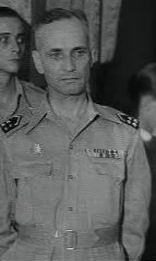
Major-general Dirk Reinhard Adelbert van Langen was a member of the Chief of Staff of the Royal Netherlands East Indies Army the Territorial Commander of East-Java and commander of the T brigade during the Indonesian War of Independence of the Royal Netherlands East Indies Army in the Dutch East Indies, from 1946 to 1949, during the Indonesian National Revolution.

The military history of Indonesia includes the military history of the modern nation of Republic of Indonesia, as well as the military history of the states which preceded and formed it. It encompassed a kaleidoscope of conflicts spanning over a millennia. The ancient and medieval part of it began as tribal warfare began among indigenous populations, and escalated as kingdoms emerged. The modern part is defined by foreign colonial occupations, battles for independence through guerrilla warfare during Indonesian National Revolution, regional conquests and disputes with neighbouring countries, as well as battles between the Republic and separatist factions. Since the formation of the Republic, the military has played significant role in state affairs. However, in Post-Suharto era, the Indonesian military has retreated from politics, yet it still possesses some influences.

The siege of Surakarta was a military campaign during the Indonesian National Revolution. The Indonesian Republican forces (TNI) briefly infiltrated the city of Surakarta before being repulsed by Dutch special forces (RST). Despite the defeat, the battle, together with an earlier attack on Yogyakarta, provided a morale boost for the Indonesians.
The Yogyakarta and Surakarta Offensive were two major offensives during the Indonesian National Revolution. The offensive started with General Offensive of 1 March 1949 and the Siege of Surakarta. Each proved a major boast for the morale of the TNI despite defeats in both actions.
The Battle of Kotabaru was a clash between Indonesian nationalists and a Japanese garrison in Yogyakarta on 7 October 1945. The Indonesians launched an attack on the Japanese garrison with the intent of acquiring weapons for use in the war of independence.
